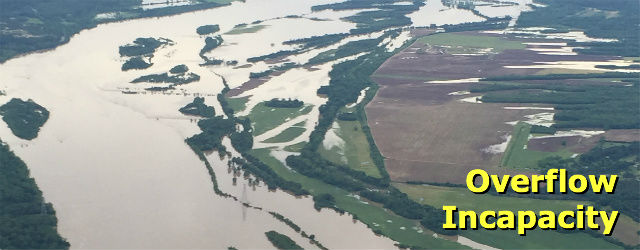Levees In Arkansas Unmaintained, With No State Oversight
by June 24, 2015 8:53 pm 685 views

Many of Arkansas’ levees are not being maintained. Taxes are being collected but not being spent for that purpose. No one is overseeing the situation because of state law and federal practices. A legislative audit report said as much in 2009, but little was done afterwards.
Those are some of the takeaways from testimony heard Wednesday by the Senate and House Committees on Insurance and Commerce and the Senate and House Committees on Agriculture, Forestry, and Economic Development.
Randy Young, executive director of the Arkansas Natural Resources Commission (ANRC), said that many of the levees are no longer managed by anyone. They were built many years ago under the management of independent boards, some of whose members have died or grown old, leaving no one responsible for maintaining them. It’s unknown how many levees exist and how many are governed by functioning districts.
His agency, and all others, are prohibited by state law from having oversight over the districts. The Federal Emergency Management Agency has a program for certification and accreditation, and if a levee is kept up to standards, it can receive federal assistance with an 80-20 match to repair damages after a flood. But involvement is voluntary and expensive.
The Bureau of Legislative Audit completed a performance audit in 2009 that came to many of the same conclusions expressed by Young and others Wednesday, but little was done then in response. Improvement districts afterwards were required by law to provide basic information to county clerks, but an ANRC survey found that only functioning districts are reporting.
“We don’t know the number of those (not reporting), or where they are,” Young said.
Young said taxes are being collected in some non-functioning levee districts. In response to questions from Rep. Stephen Meeks, R-Greenbrier, he said he doesn’t know how the money is being used.
“I’ve heard that numerous times during my career is that there are actually taxes being collected and the only person that knows they’re being collected is the attorney who was at one point employed by this group,” Jones said.
Young told legislators a process needs to be created to identify non-functioning districts, probably at the county level. He also said the lack of oversight should be addressed.
Miller County Judge Larry Burgess said that county officials likewise have no authority over the levee boards, which can raise and lower their own assessments. One district had $163,000 in its accounts, plus a $30,000 CD. He said an examination of boards’ finances in his county revealed financial records with no receipts and a check that a board secretary wrote to himself because he is also an engineer. He said the county has no authority to make the boards maintain their levees.
“It’s almost like a homeowners’ association. There’s nothing I can do. I mean, I’m not in the loop,” he said.
Sen. Jason Rapert, R-Conway, chairman of the Senate Insurance and Commerce Committee, said afterwards that the Legislature could act if a special session is held. Gov. Asa Hutchinson said the issue might be better debated during a regular session.
“This is a big lift,” Hutchinson said at the Capitol. “It looks to me like it’s something that’s more suited for … a regular session discussion, but let’s wait and see how it develops as to the needs.”
Hutchinson said the solution could involve continued use of levee boards with a greater state oversight role.
The issue came to light during this spring’s flooding events. One of those unmaintained levees failed, leaving part of Rapert’s acreage that’s below a Perry County levee beneath five or six feet of water, ruining about 100 bales of hay. He said he learned that part of the levee had been sandbagged about 25 years prior – his information source being the National Guard members who did the sandbagging. It has not been maintained since.
That was the only known instance of an outright failure, said Tony Batey, chief of the Engineering and Construction Division of the U.S. Army Corps of Engineers’ Little Rock division. In fact, he said most levees “performed quite well.” But the flooding shined a light on the state’s unmaintained levee situation.
Batey said that states surrounding Arkansas have the same issues with “losing the thread of responsibility.”
Walter Delp, the Natural Resources Conservation Service’s Arkansas state conservation engineer, said the situation is similar with some of the state’s dams.
Of the 208 dams his agency oversees, 138 will reach 50 years of age by 2020, and at that point, his agency will no longer have any legal ability to maintain them.
Thirty of the state’s dams were low-risk when they were constructed, but structures have since been built in the path of potential floodwaters. As with levees, many boards are inactive.
